Microclimate Variability in a Highly Dynamic Karstic System
Abstract
1. Introduction
2. Geological, Speleological, and Climate Setting
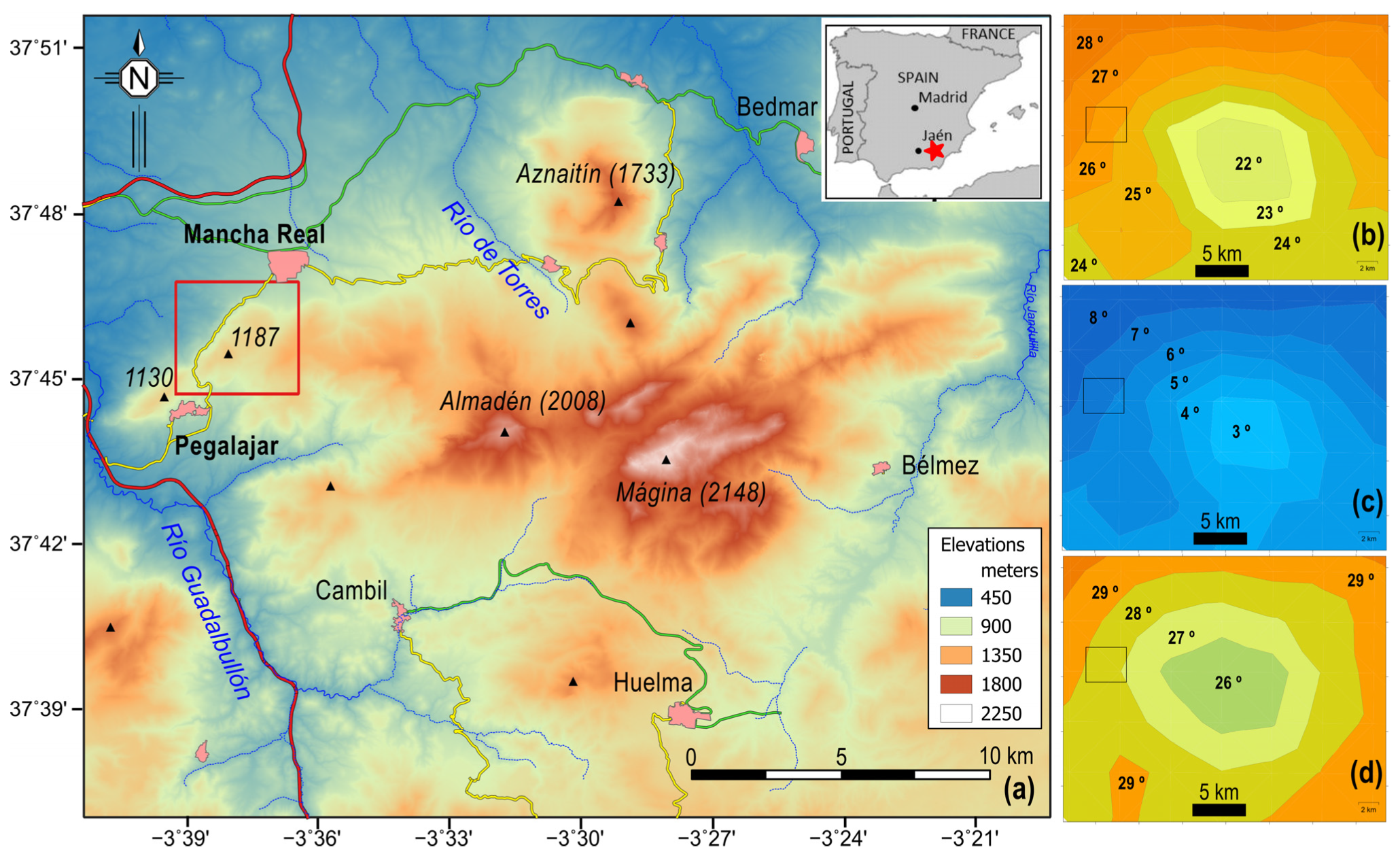
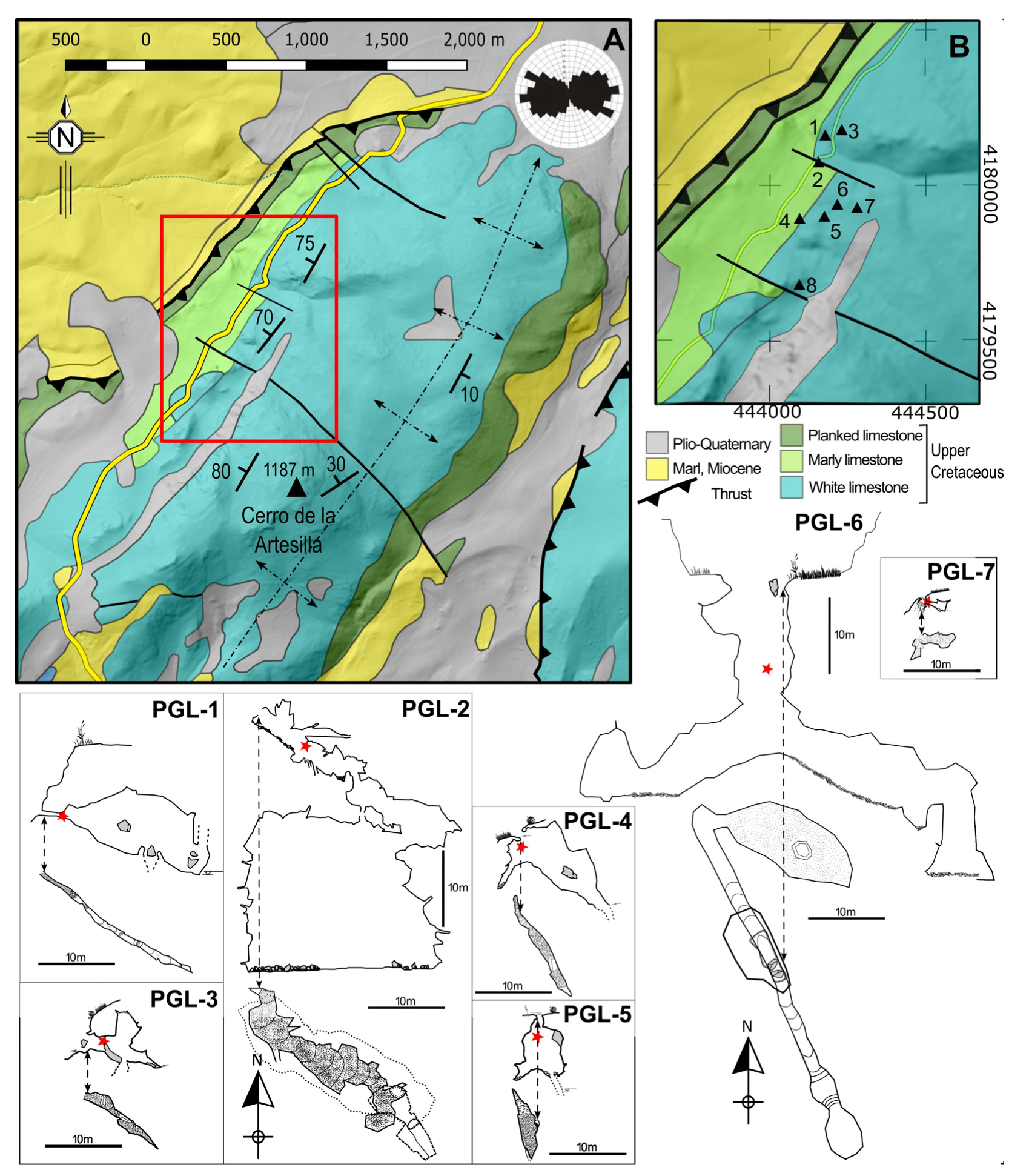
3. Materials and Methods
3.1. Studied Caves
3.2. Climatic Database
3.3. Microclimatic Monitoring
4. Results
5. Discussion
6. Conclusions
Supplementary Materials
Author Contributions
Funding
Data Availability Statement
Acknowledgments
Conflicts of Interest
References
- Buecher, R.H. Microclimate study of Kartchner Caverns, Arizona. J. Cave Karst Stud. 1999, 61, 108–120. [Google Scholar]
- Badino, G. Underground drainage systems and geothermal flux. Acta Carsol. 2005, 34, 277–316. [Google Scholar] [CrossRef]
- Badino, G. Geothermal flux and phreatic speleogenesis in gypsum, halite, and quartzite rocks. Int. J. Speleol. 2018, 47, 1–11. [Google Scholar] [CrossRef]
- Pardo-Igúzquiza, E.; Dowd, P.A.; Durán, J.J.; Robledo-Ardila, P. A review of fractals in karst. Int. J. Speleol. 2019, 48, 11–20. [Google Scholar] [CrossRef]
- Kukuljan, L.; Gabrovšek, F.; Covington, M.D.; Johnston, V.E. CO2 dynamics and heterogeneity in a cave atmosphere: Role of ventilation patterns and airflow pathways. Theor. Appl. Climatol. 2021, 146, 91–109. [Google Scholar] [CrossRef]
- Drogue, C. Geothermal gradients and ground water circulation in fissured and karstic rocks: The role played by the structure of the permeable network. J. Geodyn. 1985, 4, 219–231. [Google Scholar] [CrossRef]
- Luetscher, M.; Jeannin, P.-Y. A process-based classification of alpine ice caves. Theor. Appl. Karstol. 2004, 17, 5–10. [Google Scholar]
- McSween, H.Y.; Moersch, J.E.; Burr, D.M.; Dunne, W.M.; Emery, J.P.; Kah, L.C.; McCanta, M.C. Conductive Heat flow. In Planetary Geoscience; Cambridge University Press: Cambridge, UK, 2019; pp. 139–142. [Google Scholar]
- Ramos, M.; De Pablo, M.A.; Sebastian, E.; Armiens, C.; Gómez-Elvira, J. Temperature gradient distribution in permafrost active layer, using a prototype of the ground temperature sensor (REMS-MSL) on Deception Island (Antarctica). Cold Reg. Sci. Technol. 2012, 72, 23–32. [Google Scholar] [CrossRef]
- Brady, N.C.; Weil, R.R. The Nature and Properties of Soils, 13th ed.; Prentince Hall: Upper Saddle River, NJ, USA, 2008; pp. 662–710. [Google Scholar]
- Larwa, B. Heat transfer model to predict temperature distribution in the ground. Energies 2019, 12, 25. [Google Scholar] [CrossRef]
- Sliwa, T.; Sojczyńska, A.; Rosen, M.A.; Kowalski, T. Evaluation of temperature profiling quality in determining energy efficiencies of borehole heat exchangers. Geothermics 2019, 78, 129–137. [Google Scholar] [CrossRef]
- Trombe, F. Traité de Spéléologie; Bibliothèque Sicientifique: Paris, France, 1952. [Google Scholar]
- Badino, G. Fisica del Clima Sotterraneo, 7th ed.; Istituto Italiano di Speleologia: Bologna, Italy, 1995. [Google Scholar]
- Peters, W.H. Air density and temperature as a cause of breathing phenomenon. In Speleo Digest—1963; Haarr, A.P., McGrew, W.C., Eds.; Pittsburgh Grotto Press, National Speleological Society: Huntsville, AL, USA, 1965; pp. 103–104. [Google Scholar]
- Lismonde, B. Climatologie du Monde Souterrain. Vents des Ténèbres, 1st ed.; Comité Départemental de Spéléologie de Isère: Eybens, France, 2002; Volume 1. [Google Scholar]
- Faimon, J.; Troppová, D.; Baldík, V.; Novotný, R. Air circulation and its impact on microclimatic variables in the Císařská Cave (Moravian Karst, Czech Republic). Int. J. Climatol. 2012, 32, 599–623. [Google Scholar] [CrossRef]
- Cigna, A. An analytical study of air circulation in caves. Int. J. Speleol. 1968, 3, 41–54. [Google Scholar] [CrossRef]
- de Freitas, C.R.; Littlbjohn, R.N.; Clarkson, T.S.; Kristament, I.S. Cave climate: Assessment of airflow and ventilation. J. Climatol. 1982, 2, 383–397. [Google Scholar] [CrossRef]
- James, E.W.; Banner, J.L.; Hardt, B. A global model for cave ventilation and seasonal bias in speleothem paleoclimate records. Geochem. Geophys. Geosyst. 2015, 16, 1044–1051. [Google Scholar] [CrossRef]
- Christoforou, C.S.; Salmon, L.G.; Cass, G.R. Air exchange within the Buddhist cave temples at Yungang, China. Atmos. Environ. 1996, 30, 3995–4006. [Google Scholar] [CrossRef]
- Kowalczk, A.J.; Froelich, P.N. Cave air ventilation and CO2 outgassing by radon-222 modeling: How fast do caves breathe? Earth Planet. Sci. Lett. 2010, 289, 209–219. [Google Scholar] [CrossRef]
- Cropley, J.B. Influence of Surface Conditions on Temperatures in Large Cave Systems. Bull. Natl. Speleol. Soc. 1965, 27, 1–10. [Google Scholar] [CrossRef]
- Badino, G. Cave temperatures and global climatic change. Int. J. Speleol. 2004, 33, 103–113. [Google Scholar] [CrossRef]
- Badino, G. Underground Meteorology—“What’s the Weather Underground? ” Podzemna Meteorologija: “ Kaksno Je Vreme V Podzemlju?” . Acta Carsol. 2010, 39, 427–448. [Google Scholar] [CrossRef]
- Domínguez-Villar, D.; Lojen, S.; Krklec, K.; Baker, A.; Fairchild, I.J. Is global warming affecting cave temperatures? Experimental and model data from a paradigmatic case study. Clim. Dyn. 2015, 45, 569–581. [Google Scholar] [CrossRef]
- McCann, S.C. Atmospheric Influences on Cave Meteorology, Jinapsan Cave, Guam: A Drip Rate Analysis. Master’s Thesis, Mississippi State University, Starkville, MS, USA, 2013. [Google Scholar]
- Benavente, J.; Vadillo, I.; Liñán, C.; del Rosal, Y.; Carrasco, F. Influence of the ventilation of a karst show cave on the surrounding vadose CO2 reservoir (Nerja, South Spain). Environ. Earth Sci. 2015, 74, 7731–7740. [Google Scholar] [CrossRef]
- Faimon, J.; Lang, M. Variances in airflows during different ventilation modes in a dynamic U-shaped cave. Int. J. Speleol. 2013, 42, 115–122. [Google Scholar] [CrossRef]
- Hoyos, M.; Cañaveras, J.C.; Sánchez-Moral, S.; Sanz-Rubio, E.; Soler, V. Microclimatic characterization of a karstic cave: Human impact on microenvironmental parameters of a prehistoric rock art cave (Candamo Cave, northern Spain). Environ. Geol. 1998, 33, 231–242. [Google Scholar] [CrossRef]
- Sainz, C.; Rábago, D.; Celaya, S.; Fernández, E.; Quindós, J.; Quindós, L.; Fernández, A.; Fuente, I.; Arteche, J.L.; Quindós, L.S. Continuous monitoring of radon gas as a tool to understand air dynamics in the cave of Altamira (Cantabria, Spain). Sci. Total Environ. 2018, 624, 416–423. [Google Scholar] [CrossRef] [PubMed]
- Fernández-Cortés, A.; Calaforra, J.M.; Sánchez-Martos, F. Spatiotemporal analysis of air conditions as a tool for the environmental management of a show cave (Cueva del Agua, Spain). Atmos. Environ. 2006, 40, 7378–7394. [Google Scholar] [CrossRef]
- Pflitsch, A.; Piasecki, J. Detection of an airflow system in Niedzwiedzia (Bear) Cave, Kletno, Poland. J. Cave Karst Stud. 2003, 65, 160–173. [Google Scholar]
- Pflitsch, A.; Wiles, M.; Horrocks, R.; Piasecki, J.; Ringeis, J. Dynamic climatologic processes of barometric cave systems using the example of jewel cave and wind cave in South Dakota, USA. Acta Carsol. 2010, 39, 449–462. [Google Scholar] [CrossRef]
- Pedrera, A.; Luque-Espinar, J.A.; Martos-Rosillo, S.; Pardo-Igúzquiza, E.; Durán-Valsero, J.J.; Martínez-Moreno, F.; Guardiola-Albert, C. Structural controls on karstic conduits in a collisional orogen (Sierra de las Nieves, Betic Cordillera, S Spain). Geomorphology 2015, 238, 15–26. [Google Scholar] [CrossRef]
- Kašing, M.; Lenart, J. Cave airflow mechanism of a crevice-type cave: A case study from Czechia. Int. J. Speleol. 2020, 49, 55–67. [Google Scholar] [CrossRef]
- Margielewski, W.; Urban, J. Gravitationally induced non-karst caves: Tectonic and morphological constrains, classification, and dating; Polish Flysch Carpathians case study. Geomorphology 2017, 296, 160–181. [Google Scholar] [CrossRef]
- Lenart, J.; Kašing, M.; Tábořík, P.; Piotrowska, N.; Pawlyta, J. The cyrilka cave—The longest crevice-type cave in Czechia: Structural controls, genesis, and age. Int. J. Speleol. 2018, 47, 379–392. [Google Scholar] [CrossRef]
- Bertozzi, B.; Pulvirenti, B.; Colucci, R.R.; di Sabatino, S. On the interactions between airflow and ice melting in ice caves: A novel methodology based on computational fluid dynamics modeling. Sci. Total Environ. 2019, 669, 322–332. [Google Scholar] [CrossRef]
- Kukuljan, L.B.; Gabrovšek, F.; Covington, M.D. The relative importance of wind-driven and chimney effect cave ventilation: Observations in postojna cave (Slovenia). Int. J. Speleol. 2021, 50, 2392. [Google Scholar] [CrossRef]
- Gabrovšek, F. How do caves breathe: The airflow patterns in karst underground. PLoS ONE. 2023, 18, e0283767. [Google Scholar] [CrossRef]
- Ruiz Ortíz, P.A. Análisis de Facies del Mesozoico de las Unidades Intermedias (Entre Castril Provincia de Granada y Jaén). Ph.D. Thesis, Universidad de Granada, Granada, Spain, 1980. [Google Scholar]
- Gollonet, J.; González-Ramón, A.; Rubio-Campos, J.C. Nuevas aportaciones sobre el funcionamiento hidrogeológico del sistema kárstico de Sierra Mágina. In Karst and Environment; Carrasco, F., Durán, J.J., Andreo, B., Eds.; Fundación Cueva de Nerja: Nerja, Spain, 2002; p. 9. [Google Scholar]
- González-Ramón, A. Hidrogeología De Los Acuíferos Kársticos De Las Sierras De Pegalajar Y Mojón Blanco (Jaén). Ph.D. Thesis, Universidad de Granada, Granada, Spain, 2007. [Google Scholar]
- García-Rossell, L.; Pezzi, M. Un karst mediterráneo supraforestal en Sierra Mágina (Jaén). Condicionamientos geológicos y geomorfológicos. Cuad. Geogr. Univ. Granad. 1975, 1, 19–75. [Google Scholar]
- Waltham, T. The engineering classification of karst with respect to the role and influence of caves. Int. J. Speleol. 2002, 31, 19–35. [Google Scholar] [CrossRef]
- Pérez-Valera, F.; Sánchez-Gómez, M.; Pérez-López, A.; Pérez-Valera, L.A. An evaporite-bearing accretionary complex in the northern front of the Betic-Rif orogen. Tectonics 2017, 36, 1006–1036. [Google Scholar] [CrossRef]
- Galindo-Zaldívar, J.; Ruano, P.; Jabaloy, A.; López-Chicano, M. Kinematics of faults between Subbetic Units during the Miocene (central sector of the Betic Cordillera). Comptes Rendus De L’académie Des Sci. Ser. IIA-Earth Planet. Sci. 2000, 331, 811–816. [Google Scholar] [CrossRef][Green Version]
- Galindo-Zaldivar, J.; Gil, A.J.; de Galdeano, C.S.; Lacy, M.C.; García-Armenteros, J.A.; Ruano, P.; Ruiz, A.M.; Martínez-Martos, M.; Alfaro, P. Active shallow extension in central and eastern Betic Cordillera from CGPS data. Tectonophysics 2015, 663, 290–301. [Google Scholar] [CrossRef]
- González-Ramón, A.; López-Chicano, M.; Rubio-Campos, J.C. Piezometric and hydrogeochemical characterization of groundwater circulation in complex karst aquifers. A case study: The Mancha Real-Pegalajar aquifer (Southern Spain). Environ. Earth. Sci. 2012, 67, 923–937. [Google Scholar] [CrossRef]
- Gómez, M.S.; Gil, D.; López, J.M.G.; Tovar, J.; García, J.L.P.; Fernández, T.; Jiménez, R. Cool-air falls from crevice caves. Bol. Soc. Esp. Espeleol. Cienc. Karst 2021, 16, 16–24. [Google Scholar]
- Lara-Fanego, V.; Ruiz-Arias, J.A.; Pozo-Vazquez, D.; Santos-Alamillos, F.J.; Tovar-Pescador, J. Evaluation of the WRF model solar irradiance forecasts in Andalusia (southern Spain). Sol. Energy 2012, 86, 2200–2217. [Google Scholar] [CrossRef]
- Perrier, F.; le Mouël, J.L. Stationary and transient thermal states of barometric pumping in the access pit of an underground quarry. Sci. Total Environ. 2016, 550, 1044–1056. Available online: http://www.sciencedirect.com/science/article/pii/S0048969716301255 (accessed on 30 January 2023). [CrossRef]
- Muladi, B.; Mucsi, L. Investigation of the spatial and temporal trends of the air temperature of the Hajnóczy cave in the Bükk mountains. Geogr. Pannonica 2014, 18, 51–61. [Google Scholar] [CrossRef][Green Version]
- Bögli, A. Karst Hydrology and Physical Speleology; Springer: Berlin/Heidelberg, Germany, 1980. [Google Scholar] [CrossRef]
- Massen, F.; Dusar, M.; Loy, W.; Vandenberghe, N. Cave volume computed on the behaviour of a blowing well (Tournai basin, W. Belgium). Terra Nova 1998, 10, 131–135. [Google Scholar] [CrossRef]
- Batiot-Guilhe, C.; Seidel, J.L.; Jourde, H.; Hébrard, O.; Bailly-Comte, V. Seasonal variations of CO2 and 222Rn in a mediterranean sinkhole—Spring (Causse d’Aumelas, SE France). Int. J. Speleol. 2007, 36, 51–56. [Google Scholar] [CrossRef]
- Pérez-García, J.L.; Sánchez-Gómez, M.; Gómez-López, J.M.; Guerra, T.; Gil, D.; Fernández, T. Georeferenced thermal infrared mages from UAV surveys as a potential tool to detect and characterize shallow cave ducts. Eng. Geol. 2018, 246, 277–287. [Google Scholar] [CrossRef]
- Pardo-Igúzquiza, E.; Luque-Espinar, J.A.; Sanz de Galdeano, C.; Durán-Valsero, J.J. The importance of fault control on the geomorphological development of a deep karst system: The case of Sima GESM, a Z-supercave in southern Spain. Discov. Geosci. 2024, 2, 78. [Google Scholar] [CrossRef]
- Gázquez, F.; Quindós, L.; Rábago, D.; Fuente, I.; Celaya, S.; Sainz, C. The role of cave ventilation in the triple oxygen and hydrogen isotope composition of condensation waters in Altamira Cave, northern Spain. J. Hydrol. 2022, 606, 127416. [Google Scholar] [CrossRef]
- Bourges, F.; Genthon, P.; Genty, D.; Lorblanchet, M.; Mauduit, E.; D’Hulst, D. Conservation of prehistoric caves and stability of their inner climate: Lessons from Chauvet and other French caves. Sci. Total Environ. 2014, 493, 79–91. [Google Scholar] [CrossRef]
- Liñán, C.; del Rosal, Y.; Carrasco, F.; Vadillo, I.; Benavente, J.; Ojeda, L. Highlighting the importance of transitional ventilation regimes in the management of Mediterranean show caves (Nerja-Pintada system, southern Spain). Sci. Total Environ. 2018, 631–632, 1268–1278. [Google Scholar] [CrossRef]
- Ladle, R.J.; Firmino, J.V.L.; Malhado, A.C.M.; Rodríguez-Durán, A. Unexplored Diversity and Conservation Potential of Neotropical Hot Caves. Conserv. Biol. 2012, 26, 978–982. [Google Scholar] [CrossRef] [PubMed]
- Mammola, S.; Piano, E.; Giachino, P.M.; Isaia, M. Seasonal dynamics and micro-climatic preference of two alpine endemic hypogean beetles. Int. J. Speleol. 2015, 44, 239–249. [Google Scholar] [CrossRef]
- Jiménez-Valverde, A.; Sendra, A.; Garay, P.; Reboleira, A.S.P.S. Energy and speleogenesis: Key determinants of terrestrial species richness in caves. Ecol. Evol. 2017, 7, 10207–10215. [Google Scholar] [CrossRef]
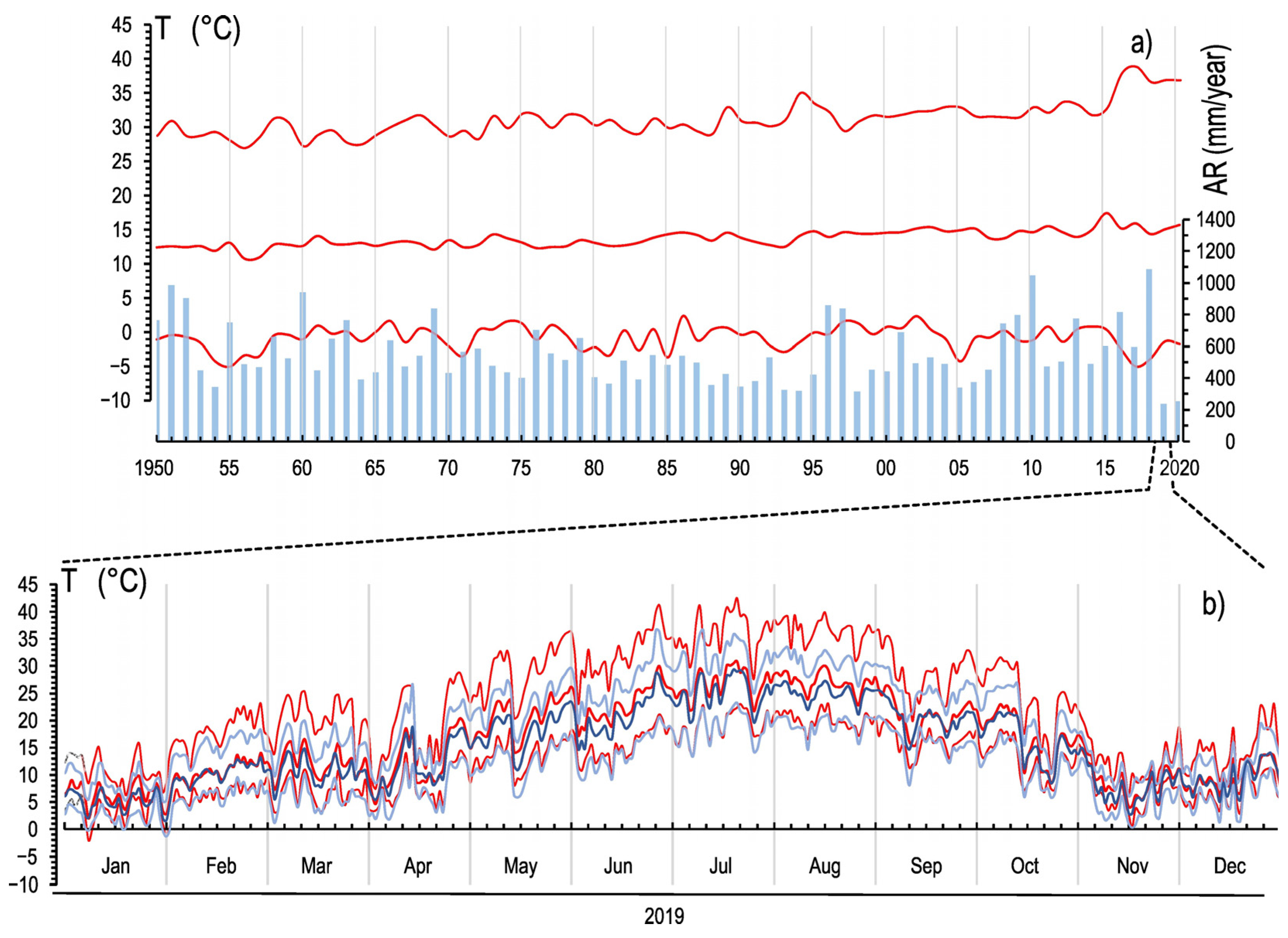
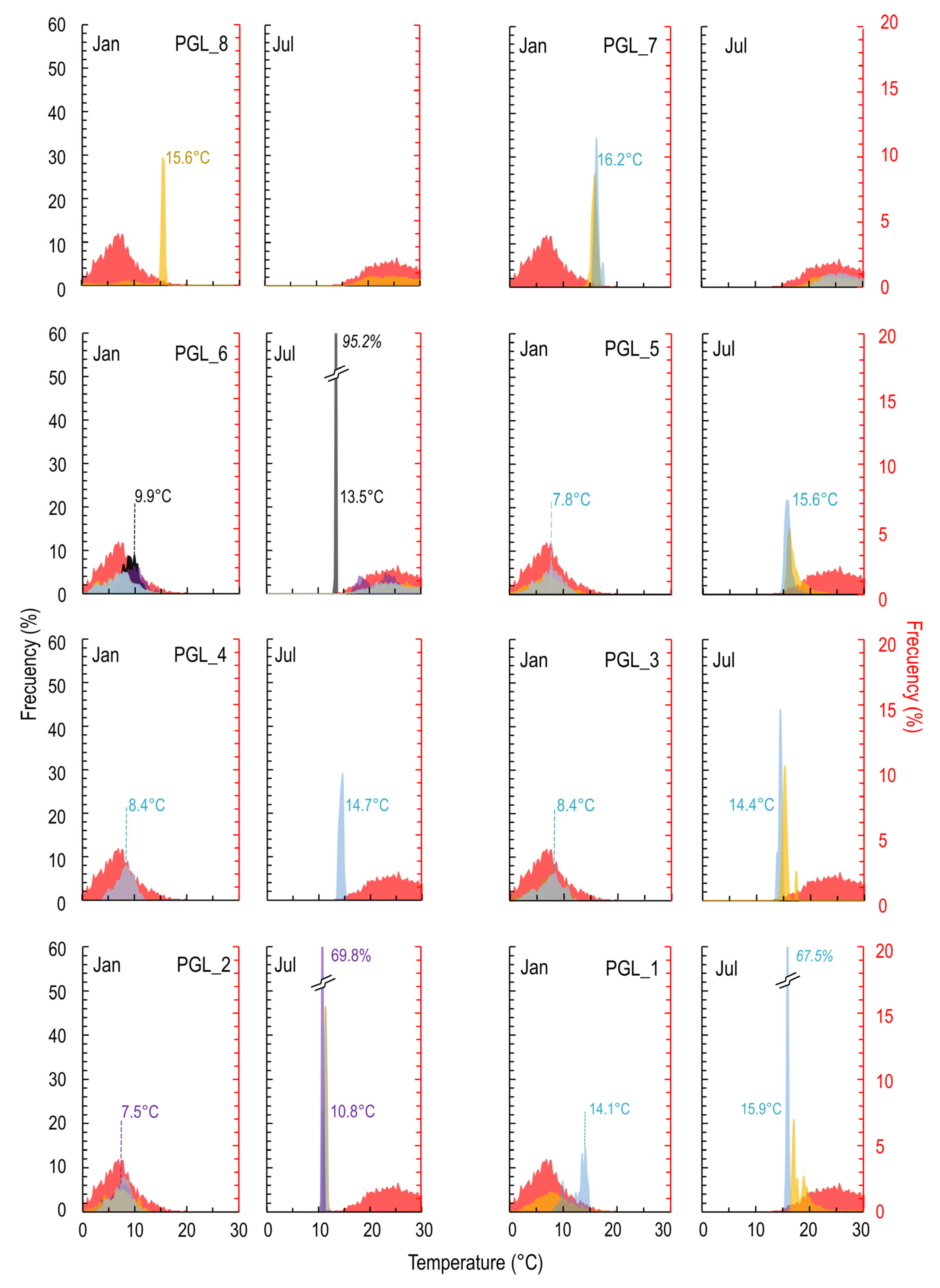
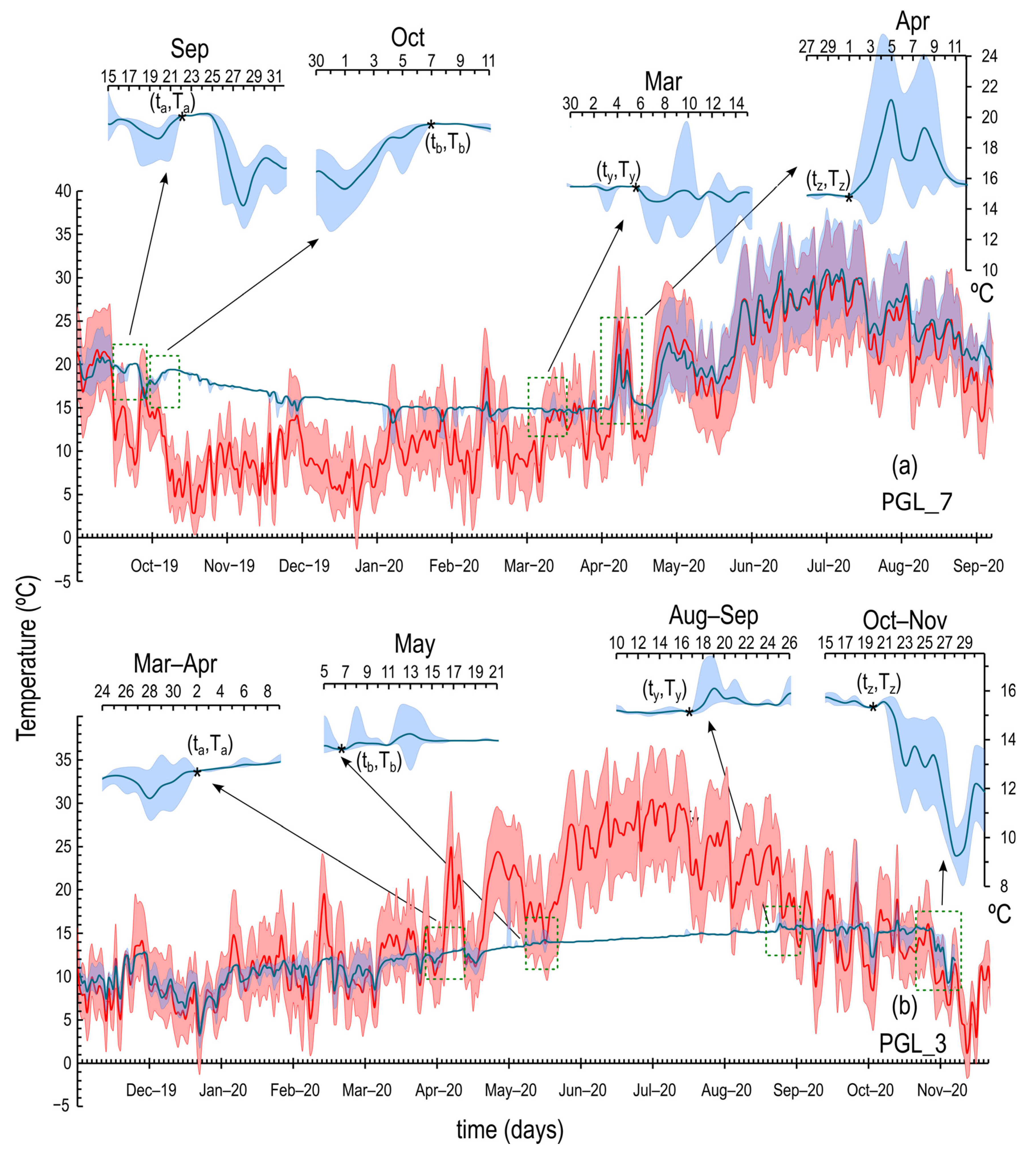
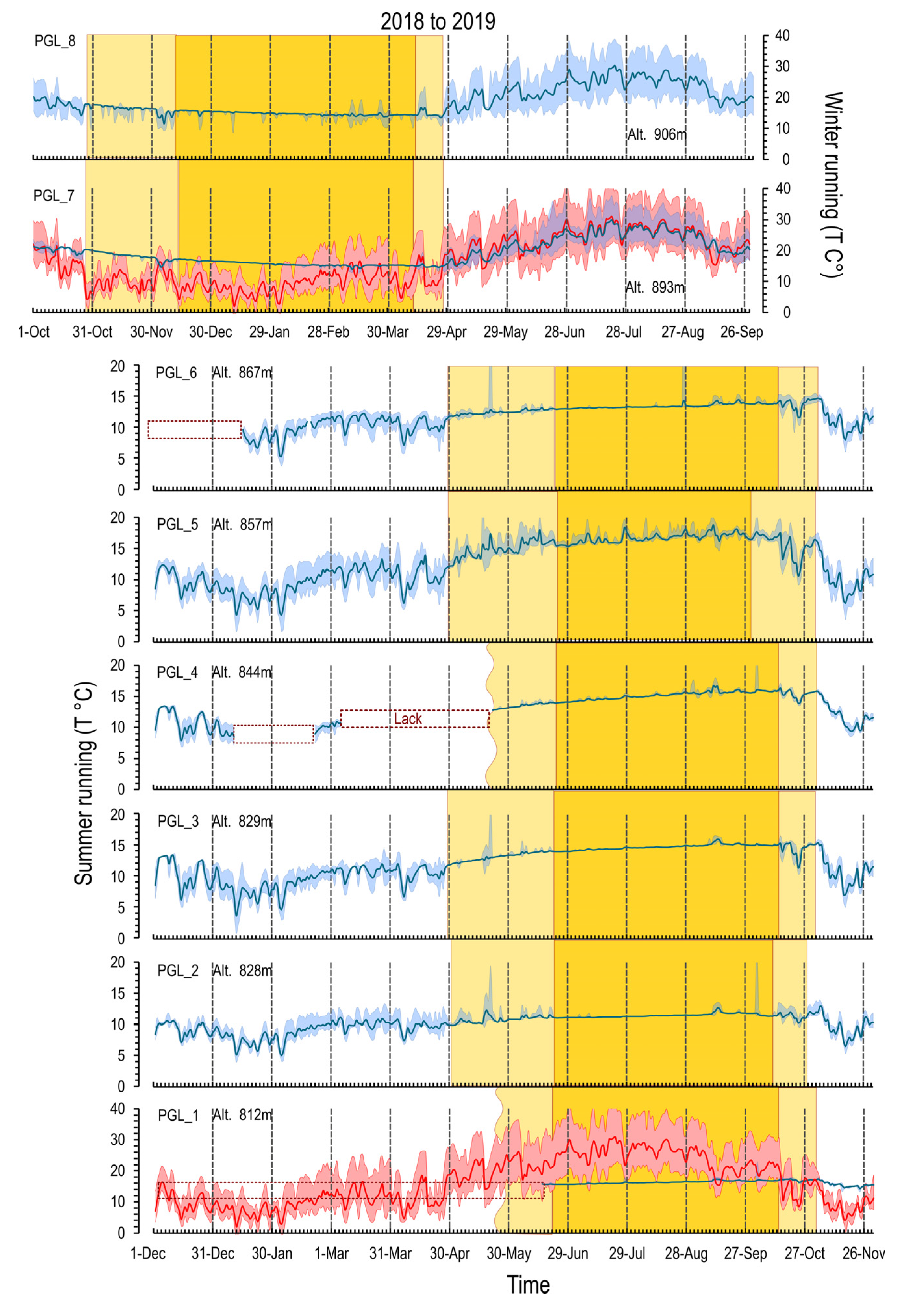
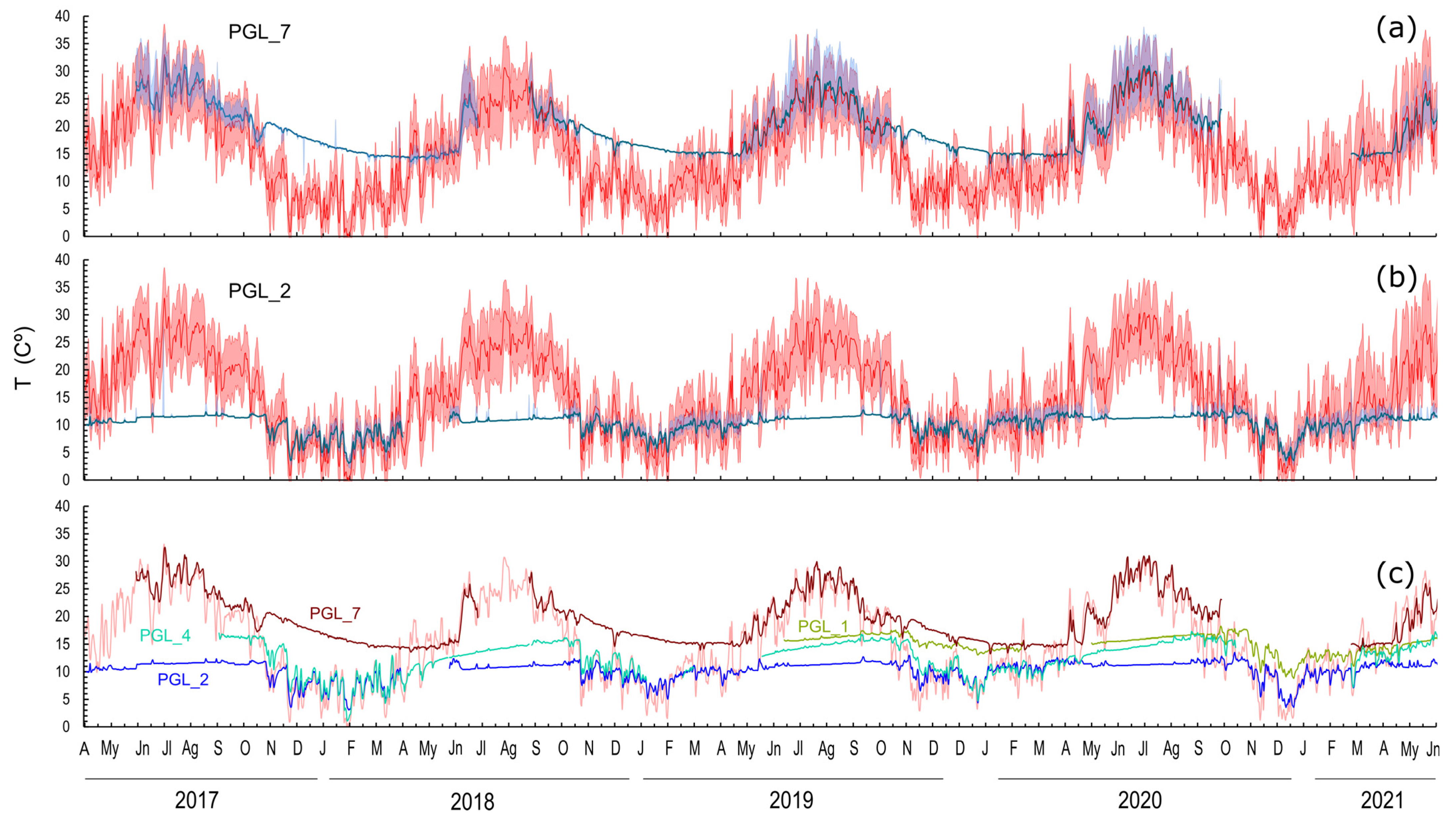
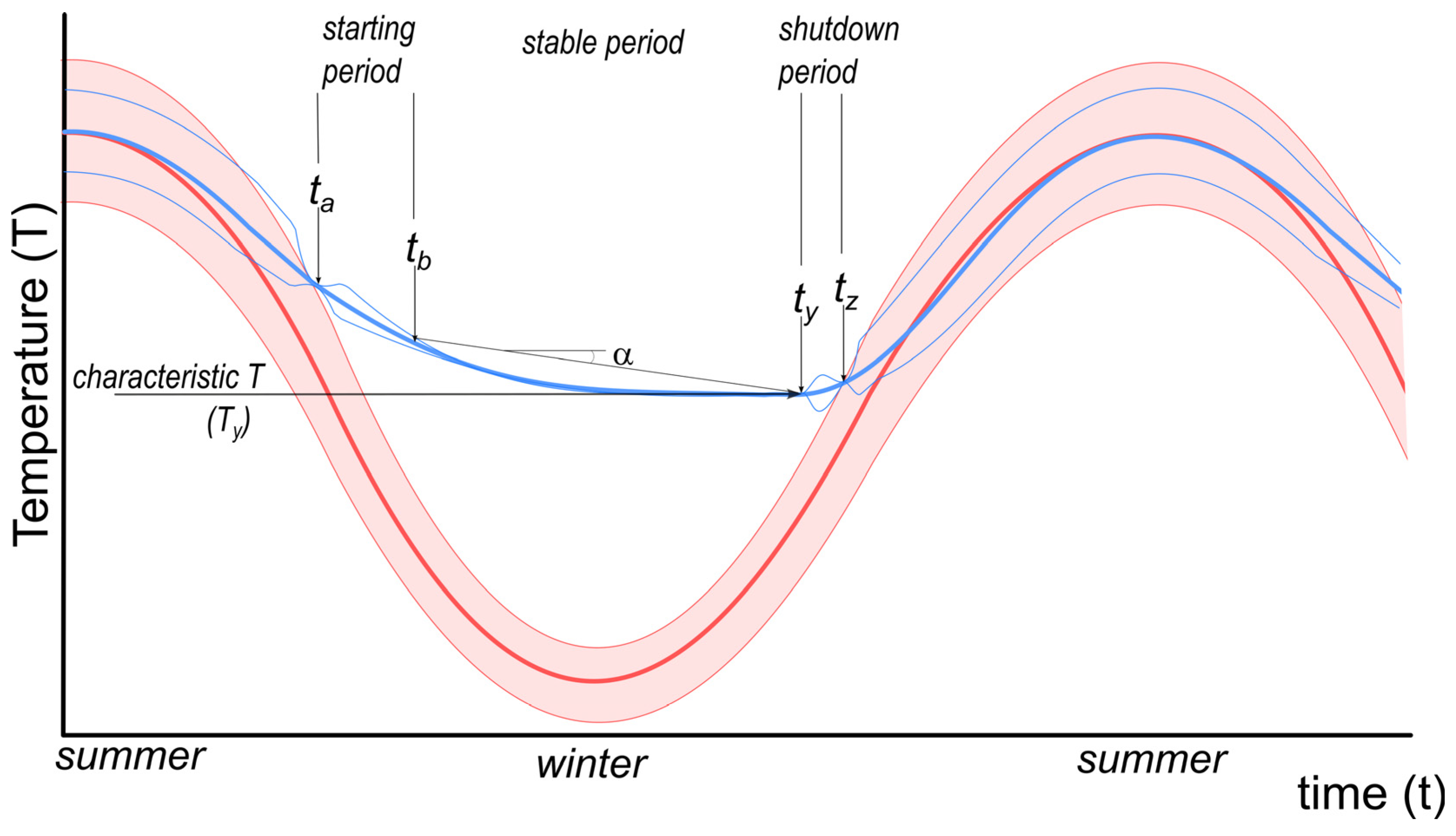
| Water Table | PGL-1 | PGL-2 | PGL-3 | PGL-4 | PGL-5 | PGL-6 | PGL-7 | PGL-8 | |
|---|---|---|---|---|---|---|---|---|---|
| Height (m) | 650 | 812 | 828 | 829 | 844 | 857 | 867 | 893 | 906 |
| Explored depth (m) | −9.5 | −34 | −5 | −7 | −12.2 | −38 | −2.4 | 3.5 | |
| Explored length (m) | 21.5 | 63 | 10.3 | 13.2 | 12.2 | 95 | 3.7 | 11 | |
| Average width (m) | 0.5 | 3.9 | 1.2 | 4 | 1.4 | 2.1 | 1.4 | 5.5 | |
| Opening axes (m·10−1) * | 7 × 6 | 15 × 9 | 30 × 4 | 10 × 9 | 7 × 5 | 73 × 15 | 5 × 3 | 16 × 7 | |
| Outflow max. vel. (m/s) | 2.4 | 4.3 | 0.9 | 1 | 1.4 | -- | 1 | 4 | |
| month | Aug. | Jul. | Sep. | Jul. | Jun. | Dec. | Mar. | ||
| Inflow max vel. (m/s) | 2 | 2.3 | 0.4 | 0.5 | 1.6 | -- | 0.5 | 1.1 | |
| month | Dec. | Dec. | Mar. | Dec. | Dec. | Jun. | Jun. | ||
| Sensor depth (m) | 3 r | 6 a | 2 a | 2.5 a | 2 a | 13 a | 2 r | 0.5 a | |
| T (°C) climax mode | 15.9 | 11.1 | 15.3 | 14.7 | 15.6 | 13.5 | 16.8 | 16.5 | |
| T (°C) shutdown mode | 16.8 | 11.4 | 15.3 | 15.6 | 17.7 | 14.1 | 15 | 14.7 | |
| T (°C) characteristic (Ty) | 17.4 | 16.8 | 11.4 | 15.2 | 16.1 | 16.9 | 14.0 | 14.8 | 14.6 |
| ∆T (°C) Ty-Tb | -- | 0.4 | 1.8 | 3.6 | 0.5 | 0.9 | −4.1 | −1.5 | |
| tanα (|∆T|/month **) | -- | 0.1 | 0.4 | 0.8 | 0.1 | 0.2 | 0.9 | 0.4 | |
| σT at tb time | -- | 0.4 | 0.6 | 1 | 1.3 | 0.1 | 1.6 | 1.3 | |
| σT characteristic (at ty) | 0 | 0.1 | 0.2 | 0 | 0.1 | 0 | 0.4 | 0 |
Disclaimer/Publisher’s Note: The statements, opinions and data contained in all publications are solely those of the individual author(s) and contributor(s) and not of MDPI and/or the editor(s). MDPI and/or the editor(s) disclaim responsibility for any injury to people or property resulting from any ideas, methods, instructions or products referred to in the content. |
© 2025 by the authors. Licensee MDPI, Basel, Switzerland. This article is an open access article distributed under the terms and conditions of the Creative Commons Attribution (CC BY) license (https://creativecommons.org/licenses/by/4.0/).
Share and Cite
Gil, D.; Sánchez-Gómez, M.; Tovar-Pescador, J. Microclimate Variability in a Highly Dynamic Karstic System. Geosciences 2025, 15, 280. https://doi.org/10.3390/geosciences15080280
Gil D, Sánchez-Gómez M, Tovar-Pescador J. Microclimate Variability in a Highly Dynamic Karstic System. Geosciences. 2025; 15(8):280. https://doi.org/10.3390/geosciences15080280
Chicago/Turabian StyleGil, Diego, Mario Sánchez-Gómez, and Joaquín Tovar-Pescador. 2025. "Microclimate Variability in a Highly Dynamic Karstic System" Geosciences 15, no. 8: 280. https://doi.org/10.3390/geosciences15080280
APA StyleGil, D., Sánchez-Gómez, M., & Tovar-Pescador, J. (2025). Microclimate Variability in a Highly Dynamic Karstic System. Geosciences, 15(8), 280. https://doi.org/10.3390/geosciences15080280






